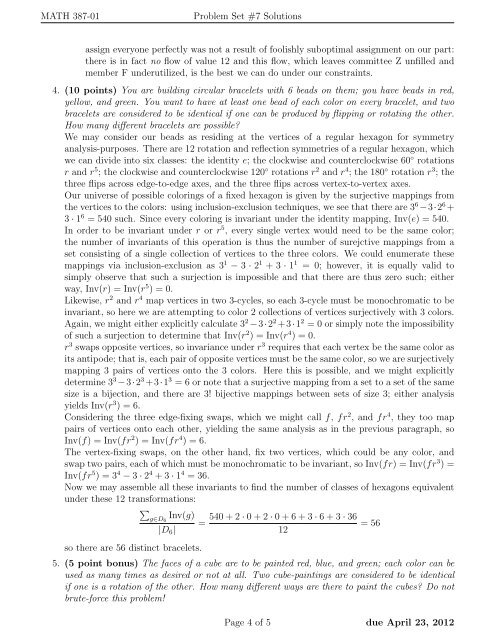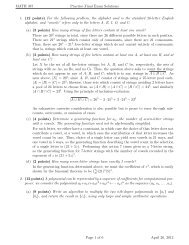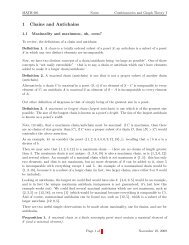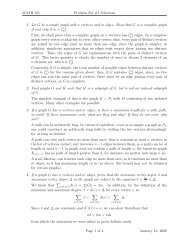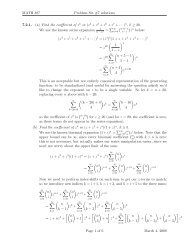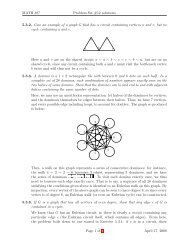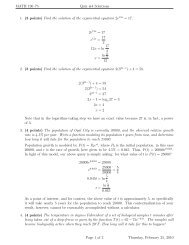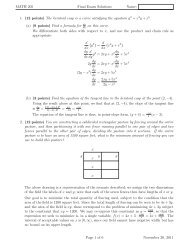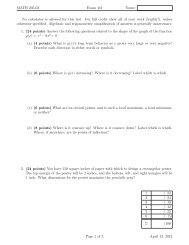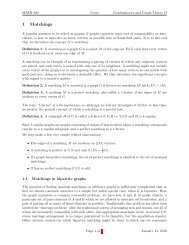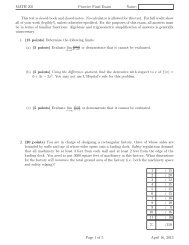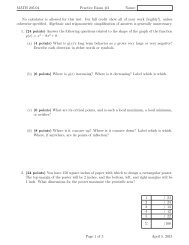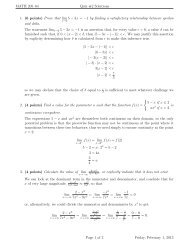MATH 387-01 Problem Set #7 Solutions 1. (10 points) Demonstrate ...
MATH 387-01 Problem Set #7 Solutions 1. (10 points) Demonstrate ...
MATH 387-01 Problem Set #7 Solutions 1. (10 points) Demonstrate ...
You also want an ePaper? Increase the reach of your titles
YUMPU automatically turns print PDFs into web optimized ePapers that Google loves.
<strong>MATH</strong> <strong>387</strong>-<strong>01</strong><br />
<strong>Problem</strong> <strong>Set</strong> <strong>#7</strong> <strong>Solutions</strong><br />
assign everyone perfectly was not a result of foolishly suboptimal assignment on our part:<br />
there is in fact no flow of value 12 and this flow, which leaves committee Z unfilled and<br />
member F underutilized, is the best we can do under our constraints.<br />
4. (<strong>10</strong> <strong>points</strong>) You are building circular bracelets with 6 beads on them; you have beads in red,<br />
yellow, and green. You want to have at least one bead of each color on every bracelet, and two<br />
bracelets are considered to be identical if one can be produced by flipping or rotating the other.<br />
How many different bracelets are possible?<br />
We may consider our beads as residing at the vertices of a regular hexagon for symmetry<br />
analysis-purposes. There are 12 rotation and reflection symmetries of a regular hexagon, which<br />
we can divide into six classes: the identity e; the clockwise and counterclockwise 60 ◦ rotations<br />
r and r 5 ; the clockwise and counterclockwise 120 ◦ rotations r 2 and r 4 ; the 180 ◦ rotation r 3 ; the<br />
three flips across edge-to-edge axes, and the three flips across vertex-to-vertex axes.<br />
Our universe of possible colorings of a fixed hexagon is given by the surjective mappings from<br />
the vertices to the colors: using inclusion-exclusion techniques, we see that there are 3 6 −3·2 6 +<br />
3 · 1 6 = 540 such. Since every coloring is invariant under the identity mapping, Inv(e) = 540.<br />
In order to be invariant under r or r 5 , every single vertex would need to be the same color;<br />
the number of invariants of this operation is thus the number of surejctive mappings from a<br />
set consisting of a single collection of vertices to the three colors. We could enumerate these<br />
mappings via inclusion-exclusion as 3 1 − 3 · 2 1 + 3 · 1 1 = 0; however, it is equally valid to<br />
simply observe that such a surjection is impossible and that there are thus zero such; either<br />
way, Inv(r) = Inv(r 5 ) = 0.<br />
Likewise, r 2 and r 4 map vertices in two 3-cycles, so each 3-cycle must be monochromatic to be<br />
invariant, so here we are attempting to color 2 collections of vertices surjectively with 3 colors.<br />
Again, we might either explicitly calculate 3 2 −3·2 2 +3·1 2 = 0 or simply note the impossibility<br />
of such a surjection to determine that Inv(r 2 ) = Inv(r 4 ) = 0.<br />
r 3 swaps opposite vertices, so invariance under r 3 requires that each vertex be the same color as<br />
its antipode; that is, each pair of opposite vertices must be the same color, so we are surjectively<br />
mapping 3 pairs of vertices onto the 3 colors. Here this is possible, and we might explicitly<br />
determine 3 3 −3·2 3 +3·1 3 = 6 or note that a surjective mapping from a set to a set of the same<br />
size is a bijection, and there are 3! bijective mappings between sets of size 3; either analysis<br />
yields Inv(r 3 ) = 6.<br />
Considering the three edge-fixing swaps, which we might call f, fr 2 , and fr 4 , they too map<br />
pairs of vertices onto each other, yielding the same analysis as in the previous paragraph, so<br />
Inv(f) = Inv(fr 2 ) = Inv(fr 4 ) = 6.<br />
The vertex-fixing swaps, on the other hand, fix two vertices, which could be any color, and<br />
swap two pairs, each of which must be monochromatic to be invariant, so Inv(fr) = Inv(fr 3 ) =<br />
Inv(fr 5 ) = 3 4 − 3 · 2 4 + 3 · 1 4 = 36.<br />
Now we may assemble all these invariants to find the number of classes of hexagons equivalent<br />
under these 12 transformations:<br />
∑<br />
g∈D 6<br />
Inv(g)<br />
|D 6 |<br />
so there are 56 distinct bracelets.<br />
=<br />
540 + 2 · 0 + 2 · 0 + 6 + 3 · 6 + 3 · 36<br />
12<br />
5. (5 point bonus) The faces of a cube are to be painted red, blue, and green; each color can be<br />
used as many times as desired or not at all. Two cube-paintings are considered to be identical<br />
if one is a rotation of the other. How many different ways are there to paint the cubes? Do not<br />
brute-force this problem!<br />
= 56<br />
Page 4 of 5 due April 23, 2<strong>01</strong>2


